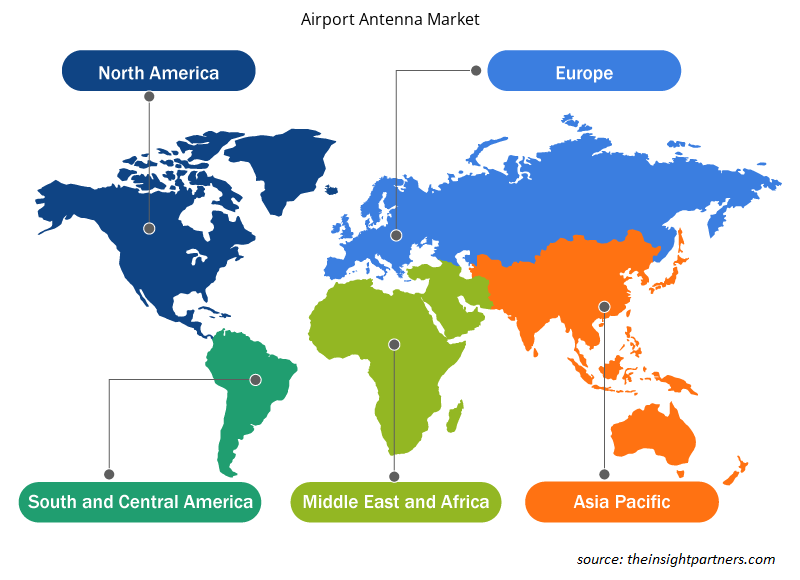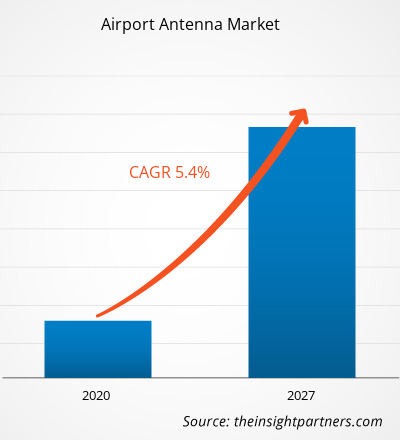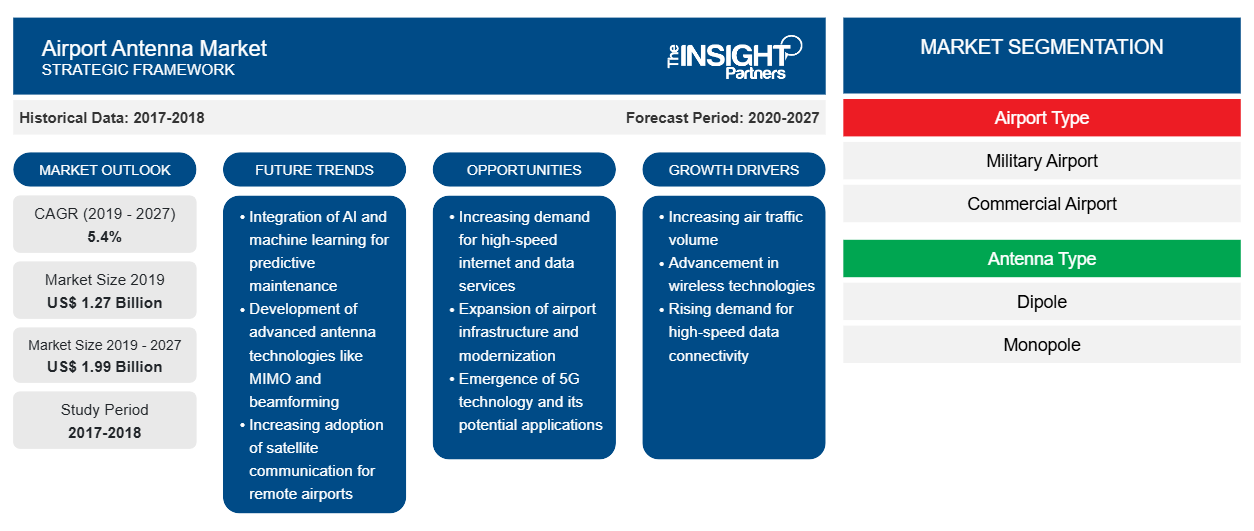Il mercato delle antenne aeroportuali è stato valutato a 1,27 miliardi di dollari nel 2019 e si prevede che raggiungerà i 1,27 miliardi di dollari.1,99 miliardi entro il 2027; si prevede una crescita a un CAGR del 5,4% durante il periodo di previsione.
Un'antenna è un dispositivo che riceve e trasmette segnali elettrici. Le antenne svolgono un ruolo importante negli aeroporti per facilitare la telefonia mobile, la comunicazione satellitare e le reti locali wireless. Un aereo utilizza antenne a radiofrequenza per navigare verso le proprie destinazioni e comunicare con il controllo del traffico aereo. Le antenne aeroportuali sono utilizzate principalmente per aeroporti militari e aeroporti commerciali. Negli aeroporti militari, le antenne consentono una comunicazione migliorata introducendo bande ad alta frequenza, altissima frequenza e ultra-alta frequenza. Queste soluzioni avanzate di antenne forniscono applicazioni veicolari, terrestri, aeree e navali che aiutano a mostrare molteplici operazioni militari.
I progressi nei sistemi di antenne aeroportuali stanno aumentando a causa della crescente costruzione e ristrutturazione di aeroporti nuovi ed esistenti in tutto il mondo. Poiché il numero di passeggeri che viaggiano con i voli è in aumento, c'è un'enorme distribuzione di antenne hotspot Wi-Fi LAN wireless negli aeroporti per fornire accesso a Internet ad alta velocità ai passeggeri. Mobile Mark, Inc., un'azienda con sede nel Regno Unito, nell'ottobre 2019 ha offerto antenne di gestione della flotta 5G per il Global Navigation Satellite System ( GNSS ) e strutture Wi-Fi che sarebbero state utilizzate per la comunicazione, la sicurezza pubblica e la gestione della flotta di veicoli.
Personalizza questo report in base alle tue esigenze
Riceverai la personalizzazione gratuita di qualsiasi report, comprese parti di questo report, o analisi a livello nazionale, pacchetto dati Excel, oltre a usufruire di grandi offerte e sconti per start-up e università
-
Scopri le principali tendenze di mercato in questo rapporto.Questo campione GRATUITO includerà analisi di dati che spaziano dalle tendenze di mercato alle stime e alle previsioni.
Impatto della pandemia di COVID-19 sul mercato delle antenne aeroportuali
L'industria aeronautica globale è una delle principali industrie che affronta gravi interruzioni come cancellazioni di voli, blocchi temporanei dei paesi e riduzione del numero di passeggeri, a causa della pandemia di COVID-19. Secondo l'Organizzazione internazionale per l'aviazione civile ( ICAO ), nel 2020, c'è stato un calo di circa il 57%-60% nel numero di passeggeri rispetto al 2019 e una perdita di entrate per passeggeri di circa 256 miliardi di $ USA da gennaio ad agosto 2020. Di conseguenza, è crollata la domanda di miglioramento dello sviluppo delle infrastrutture aeroportuali, inclusa la domanda di antenne aeroportuali a livello globale. Inoltre, il blocco di vari impianti e fabbriche che sviluppano componenti, sensori, controller e materiali per antenne in regioni leader come Nord America, Europa, Medio Oriente e Africa e Sud America sta influenzando le catene di fornitura globali e influenzando negativamente gli sviluppi negli aeroporti, la creazione di nuovi aeroporti e le materie prime.
Approfondimenti sul mercato delle antenne aeroportuali
Impennata nello sviluppo e nella modernizzazione delle infrastrutture aeroportuali
I governi di diversi paesi si stanno concentrando sul potenziamento delle infrastrutture aeroportuali, a causa del crescente numero di passeggeri aerei in tutto il mondo. Secondo le stime ventennali dell'International Air Transport Association (IATA), si prevede che il numero di passeggeri aerei globali raggiungerà circa 8,2 miliardi entro il 2037, con un CAGR del 3,5%. Secondo i calcoli IATA, si prevede che il settore dell'aviazione assisterà a una crescita robusta nei prossimi 20 anni e offrirà diversi vantaggi ai vari stakeholder coinvolti nell'ecosistema. Si prevede che il Nord America crescerà con un CAGR del 2,4%, ovvero circa 1,4 miliardi di passeggeri e l'Europa dovrebbe crescere con un CAGR del 2,0%, ovvero circa 1,9 miliardi di passeggeri durante il periodo di previsione. Tuttavia, si prevede che la parte significativa della crescita provenga dall'Est del mondo. IATA ha anche stimato che l'APAC dovrebbe essere il principale contributore alle entrate del settore dell'aviazione globale a causa della crescente crescita del traffico aereo in paesi come India, Singapore, Cina e Giappone. Si prevede che l'area APAC registrerà un aumento del numero di passeggeri a circa 2,35 miliardi entro il 2037 e raggiungerà circa 3,90 miliardi di passeggeri entro il 2037.
Approfondimenti di mercato basati sul tipo di aeroporto
In base al tipo di aeroporto, il mercato delle antenne aeroportuali è segmentato in aeroporti militari e aeroporti commerciali. L'antenna aeroportuale negli aeroporti è utilizzata per diverse applicazioni, tra cui sorveglianza, navigazione e comunicazioni terra-aria. Le antenne aeroportuali militari sono antenne appositamente progettate secondo gli standard militari e sono diverse dalle antenne aeroportuali commerciali. Il crescente numero di aeroporti militari e commerciali in tutto il mondo è uno dei principali fattori che supportano la crescita del mercato delle antenne aeroportuali. Inoltre, le aziende nel mercato delle antenne aeroportuali si stanno concentrando sull'offerta di soluzioni all'avanguardia per soddisfare i requisiti specifici degli aeroporti commerciali e militari.
Approfondimenti di mercato basati sul tipo di antenna
In base al tipo di antenna, il mercato delle antenne aeroportuali è segmentato in antenna monopolare e antenna dipolare. Le antenne dipolari sono utilizzate negli aeroporti per comunicazioni, sorveglianza e altre applicazioni. Le antenne monopolari sono adatte per RFID e reti wireless. Le aziende che operano nel mercato si stanno concentrando sull'introduzione di antenne efficienti per migliorare le prestazioni delle infrastrutture aeroportuali.
Approfondimenti di mercato basati sulla banda di frequenza
In base alla banda di frequenza, il mercato delle antenne aeroportuali è suddiviso in Alta frequenza (HF), Altissima frequenza (VHF) e Ultra alta frequenza (UHF). Le antenne HF sono utilizzate per scopi di comunicazione negli aeroporti. Le antenne VHF e UHF sono utilizzate per applicazioni punto-punto, terra-aria e aria-terra. Le aziende che operano nel mercato offrono antenne HF, UHF e VHF in varie configurazioni, caratteristiche e caratteristiche per soddisfare le esigenze di varie installazioni. Alcune aziende offrono anche prodotti personalizzati per soddisfare le esigenze specifiche dei loro clienti.
Approfondimenti di mercato basati sulle applicazioni
In base all'applicazione, il mercato delle antenne aeroportuali è segmentato in SATCOM, sorveglianza, navigazione e altri. Le antenne aeroportuali sono integrate con varie infrastrutture aeroportuali che vengono utilizzate per diverse applicazioni in aeroporto. Le antenne aeroportuali aiutano a evitare collisioni, monitorare gli aeromobili e gestire il traffico aereo per migliorare l'efficienza dell'aeroporto. Inoltre, si prevede che il crescente traffico aereo, un numero crescente di aeroporti e una forte enfasi sulla sicurezza degli aeromobili e sul miglioramento del flusso del traffico aereo sosterranno la crescente domanda di antenne aeroportuali per diverse applicazioni. Le aziende che operano nel mercato stanno anche lavorando rigorosamente per offrire antenne efficienti per diverse applicazioni aeroportuali per raggiungere una forte posizione di mercato.
Approfondimenti regionali sul mercato delle antenne aeroportuali
Le tendenze regionali e i fattori che influenzano il mercato delle antenne aeroportuali durante il periodo di previsione sono stati ampiamente spiegati dagli analisti di Insight Partners. Questa sezione discute anche i segmenti e la geografia del mercato delle antenne aeroportuali in Nord America, Europa, Asia Pacifico, Medio Oriente e Africa e Sud e Centro America.

- Ottieni i dati specifici regionali per il mercato delle antenne aeroportuali
Ambito del rapporto sul mercato delle antenne aeroportuali
| Attributo del report | Dettagli |
|---|---|
| Dimensioni del mercato nel 2019 | 1,27 miliardi di dollari USA |
| Dimensioni del mercato entro il 2027 | 1,99 miliardi di dollari USA |
| CAGR globale (2019 - 2027) | 5,4% |
| Dati storici | 2017-2018 |
| Periodo di previsione | 2020-2027 |
| Segmenti coperti |
Per tipo di aeroporto
|
| Regioni e Paesi coperti |
America del Nord
|
| Leader di mercato e profili aziendali chiave |
|
Densità degli operatori del mercato delle antenne aeroportuali: comprendere il suo impatto sulle dinamiche aziendali
Il mercato delle antenne aeroportuali sta crescendo rapidamente, spinto dalla crescente domanda degli utenti finali dovuta a fattori quali l'evoluzione delle preferenze dei consumatori, i progressi tecnologici e una maggiore consapevolezza dei vantaggi del prodotto. Con l'aumento della domanda, le aziende stanno ampliando le loro offerte, innovando per soddisfare le esigenze dei consumatori e capitalizzando sulle tendenze emergenti, il che alimenta ulteriormente la crescita del mercato.
La densità degli operatori di mercato si riferisce alla distribuzione di aziende o società che operano in un particolare mercato o settore. Indica quanti concorrenti (operatori di mercato) sono presenti in un dato spazio di mercato in relazione alle sue dimensioni o al valore di mercato totale.
Le principali aziende che operano nel mercato delle antenne aeroportuali sono:
- Società Northrop Grumman
- Cobham limitata
- Antenna Wade, Inc.
- Amphenol Procom
- Società di prodotti per antenne
Disclaimer : le aziende elencate sopra non sono classificate secondo un ordine particolare.

- Ottieni una panoramica dei principali attori del mercato delle antenne aeroportuali
Gli attori del mercato delle antenne aeroportuali si concentrano su strategie quali iniziative di mercato, acquisizioni e lanci di prodotti per mantenere le loro posizioni sul mercato. Di seguito sono elencati alcuni sviluppi da parte degli attori chiave:
Nel 2020, HENSOLDT South Africa ha acquisito le attività di difesa e sicurezza Tellumat e Air Traffic Management. Questa strategia aiuterà HENSOLDT ad ampliare ulteriormente il suo portafoglio e la sua presenza in Africa.
Nel 2019, NAV CANADA ha messo in funzione il primo radar di movimento di superficie a stato solido SCANTER 5502 nel più grande aeroporto del paese, a Toronto. L'azienda fornisce la nuova antenna antighiaccio riscaldata che può impedire che il ghiaccio si accumuli sull'antenna durante la rotazione.
Mercato delle antenne aeroportuali – per tipo di aeroporto
- Aeroporto commerciale
- Aeroporto militare
Mercato delle antenne aeroportuali – per tipo di antenna
- Dipolo
- Monopolo
Mercato delle antenne aeroportuali – per banda di frequenza
- Alta frequenza
- Frequenza molto alta
- Frequenza ultra alta
Mercato delle antenne aeroportuali – per applicazione
- COMUNICAZIONE SATELLITARE
- Navigazione
- Sorveglianza
- Altri
Mercato delle antenne aeroportuali – per area geografica
-
America del Nord
- NOI
- Canada
- Messico
-
Europa
- Regno Unito
- Germania
- Francia
- Italia
- Spagna
- Svizzera
- Scandinavia
- Resto d'Europa
-
Asia Pacifico (APAC)
- Cina
- Giappone
- India
- Australia
- Corea del Sud
- Singapore
- Malaysia
- Thailandia
- Resto dell'APAC
-
Medio Oriente e Africa (MEA)
- Arabia Saudita
- Emirati Arabi Uniti
- Sudafrica
- Resto del MEA
-
America del Sud (SAM)
- Brasile
- Argentina
- Chile
- Resto del SAM
Mercato delle antenne aeroportuali – CompanyProfiles
- Società Northrop Grumman
- Cobham limitata
- Antenna Wade, Inc.
- Amphenol Procom
- Società di prodotti per antenne
- Comunicazione Comrod AS
- HENSOLDT Inc
- La Rohde & Schwarz GmbH & Co.
- Termine
- Azienda di antenne Watts
- Analisi storica (2 anni), anno base, previsione (7 anni) con CAGR
- Analisi PEST e SWOT
- Valore/volume delle dimensioni del mercato - Globale, Regionale, Nazionale
- Industria e panorama competitivo
- Set di dati Excel
Report recenti
Rapporti correlati
Testimonianze
Motivo dell'acquisto
- Processo decisionale informato
- Comprensione delle dinamiche di mercato
- Analisi competitiva
- Analisi dei clienti
- Previsioni di mercato
- Mitigazione del rischio
- Pianificazione strategica
- Giustificazione degli investimenti
- Identificazione dei mercati emergenti
- Miglioramento delle strategie di marketing
- Aumento dell'efficienza operativa
- Allineamento alle tendenze normative























 Ottieni un campione gratuito per - Mercato delle antenne aeroportuali
Ottieni un campione gratuito per - Mercato delle antenne aeroportuali